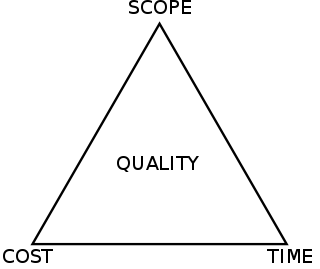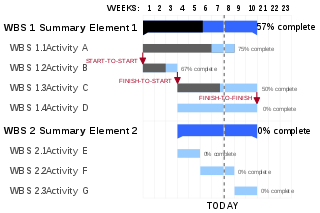A management information system (MIS) is an information system used for decision-making, and for the coordination, control, analysis, and visualization of information in an organization; especially in a company.
In organizational studies, resource management is the efficient and effective development of an organization's resources when they are needed. Such resources may include financial resources, inventory, human skills, production resources, or information technology (IT) and natural resources.

Microsoft Project is a project management software product, developed and sold by Microsoft. It is designed to assist a project manager in developing a plan, assigning resources to tasks, tracking progress, managing the budget, and analyzing workloads.

Microsoft Office Project Server is a project management server solution made by Microsoft since 2000. It uses Microsoft SharePoint as its foundation, and supports interface from either Microsoft Project as a client application or by web browser connecting to its Project Web App (PWA) component.
Oracle Applications comprise the applications software or business software of the Oracle Corporation. The term refers to the non-database and non-middleware parts.
Project Portfolio Management (PPM) is a senior leadership discipline that drives strategic execution and maximizes business value delivery through the selection, optimization, and oversight of project investments which align to business goals and strategies. PPM is the centralized management of the processes, methods, and technologies used by project managers and project management offices (PMOs) to analyze and collectively manage current or proposed projects based on numerous key characteristics. The objectives of PPM are to determine the optimal resource mix for delivery and to schedule activities to best achieve an organization’s operational and financial goals, while honouring constraints imposed by customers, strategic objectives, or external real-world factors. The International standard defines the framework of the Project Portfolio Management
Workforce management (WFM) is an institutional process that maximizes performance levels and competency for an organization. The process includes all the activities needed to maintain a productive workforce, such as field service management, human resource management, performance and training management, data collection, recruiting, budgeting, forecasting, scheduling and analytics.
Capacity management's primary goal is to ensure that information technology resources are right-sized to meet current and future business requirements in a cost-effective manner. One common interpretation of capacity management is described in the ITIL framework. ITIL version 3 views capacity management as comprising three sub-processes: business capacity management, service capacity management, and component capacity management.
In project management, the resource breakdown structure (RBS) is a hierarchical list of resources related by function and resource type that is used to facilitate planning and controlling of project work. The Resource Breakdown Structure includes, at a minimum, the personnel resources needed for successful completion of a project, and preferably contains all resources on which project funds will be spent, including personnel, tools, machinery, materials, equipment and fees and licenses. Money is not considered a resource in the RBS; only those resources that will cost money are included.

Cloud computing makes computer system resources, especially storage and computing power, available on demand without direct active management by the user. The term is generally used to describe data centers available to many users over the Internet. Large clouds, predominant today, often have functions distributed over multiple locations from central servers. If the connection to the user is relatively close, it may be designated an Edge server.

The Project Management Triangle is a model of the constraints of project management. While its origins are unclear, it has been used since at least the 1950s. It contends that:
- The quality of work is constrained by the project's budget, deadlines and scope (features).
- The project manager can trade between constraints.
- Changes in one constraint necessitate changes in others to compensate or quality will suffer.
IBM Tivoli Storage Productivity Center (TPC) is a Storage Resource Management (SRM) software offering that provides a centralized point of control for managing large-scale, complex heterogeneous storage environments. IBM Tivoli Storage Productivity Center V5.2.x (5608-PC1) was renamed in V5.2.8 to IBM Spectrum Control Standard Edition V5.2.x (5608-PC1).
This entry describes performance management in an Information Technology context. SeePerformance Managementfor a description of performance management in a more general context.
OpenNebula is a cloud computing platform for managing heterogeneous distributed data center infrastructures. The OpenNebula platform manages a data center's virtual infrastructure to build private, public and hybrid implementations of infrastructure as a service. The two primary uses of the OpenNebula platform are data center virtualization solutions and cloud infrastructure solutions. The platform is also capable of offering the cloud infrastructure necessary to operate a cloud on top of existing infrastructure management solutions. OpenNebula is free and open-source software, subject to the requirements of the Apache License version 2.
Software-defined storage (SDS) is a marketing term for computer data storage software for policy-based provisioning and management of data storage independent of the underlying hardware. Software-defined storage typically includes a form of storage virtualization to separate the storage hardware from the software that manages it. The software enabling a software-defined storage environment may also provide policy management for features such as data deduplication, replication, thin provisioning, snapshots and backup.

Spider Project is a project management software, developed by a Russian company, Spider Project Team.
A human resources management system (HRMS) or human resources information system (HRIS) is a form of human resources (HR) software that combines a number of systems and processes to ensure the easy management of human resources, business processes and data. Human resources software is used by businesses to combine a number of necessary HR functions, such as storing employee data, managing payrolls, recruitment processes, benefits administration, and keeping track of attendance records. It ensures everyday human resources processes are manageable and easy to access. It merges human resources as a discipline and, in particular, its basic HR activities and processes with the information technology field, whereas the programming of data processing systems evolved into standardized routines and packages of enterprise resource planning (ERP) software. On the whole, these ERP systems have their origin from software that integrates information from different applications into one universal database. The linkage of its financial and human resource modules through one database is the most important distinction to the individually and proprietarily developed predecessors, which makes this software application both rigid and flexible.
Data center management is the collection of tasks performed by those responsible for managing ongoing operation of a data center This includes Business service management and planning for the future.















